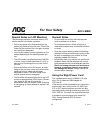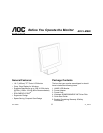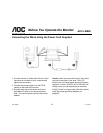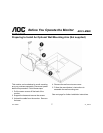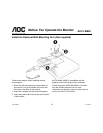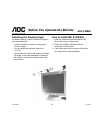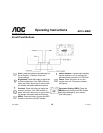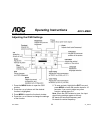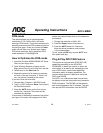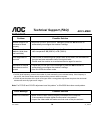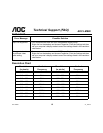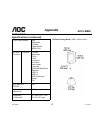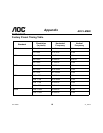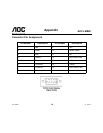
AOC LM800
12
v3_123102
AOC LM800
Operating Instructions
DOS-mode
This feature allows you to choose between
resolutions of 720 x 400 or 640 x 400 while
working in DOS-mode. Follow the instructions for
selecting functions in the OSD window as listed on
the previous page. Press your monitor’s Power
button off and then on to activate your chosen
DOS-mode resolution. Note: the default DOS-
mode resolution is 720x400@70Hz.
How to Optimize the DOS-mode
1. Insert the Windows 95/98/2000/ME INF Driver
Disk into your floppy drive.
2. Open Windows Explorer to search on the
floppy drive (Drive A:) to find the Dos1.exe file.
3. Double-click on the Dos1.exe file.
4. Expand the picture to full screen by pressing
the icon on the top of window. If there is no
icon, the picture is already at full screen.
If you don't have the driver disk:
1. Choose Start / Programs / MS-DOS mode.
2. Type C:\> EDIT and press Enter. You will be in
the Dos-Editor screen.
3. Press the AUTO button on the front of your
monitor for 2 seconds. The screen will be
automatically adjusted.
If the screen is distorted (for example: the picture
can't go to full screen, the background of white
pattern has vertical stripe noise, or the characters
are twisted):
1. Change the resolution to 640 x 400
2. Press the Power button off and then on.
3. Press the AUTO button for 2 seconds.
Note: the above procedure must process
in full-screen pattern.
To exit, press the ESC key or press ALT-F, and
then press the X key.
Plug & Play DDC1/2B Feature
This monitor is equipped with VESA DDC1/2B
capabilities according to the VESA DDC
STANDARD. It allows the monitor to inform the
host system of its identity and, depending on the
level of DDC used, communicate additional
information about its display capabilities. The
communication channel is defined in two levels,
DDC1 and DDC2B.
The DDC1 is a unidirectional data channel from
the display to the host that continuously transmits
EDID information. The DDC2B is a bidirectional
data channel based on the I²C protocol. The host
can request EDID information over the DDC2B.



